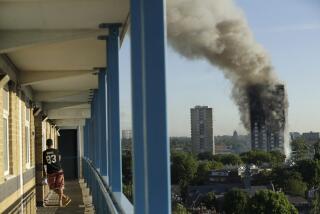Crane Firm’s Safety Record Not Checked
- Share via
SAN FRANCISCO — The president of the construction firm in charge of a building project where a 240-ton crane fell and killed five people here last November said Thursday that he was unaware of the extremely poor safety record of the subcontractor hired to operate the crane.
The problem is “we don’t deal with safety” records when it comes to hiring subcontractors, said David Grubb, president of Swinerton & Walberg, a large company with a good reputation for safety on its own.
Grubb, testifying before a House subcommittee studying the lack of federal regulation of cranes and those who operate them, said his company now is paying more attention to subcontractor histories.
The Erection Co., a Seattle-based firm hired by Swinerton & Walberg to put up high-rise steel at a building in downtown San Francisco, was cited for 59 violations between 1985 and 1988 by Washington state work-safety officials, according to testimony by Gerard F. Scannell, chief of the federal Occupational Safety and Health Administration. The state officials had proposed penalties of $110,000.
Grubb said that before the accident his company regularly checked out subcontractors’ bondability and industry reputation, but “our diligence . . . would not have taken into account safety.”
He acknowledged that the speed of the construction bidding process is among the factors that discourage general contractors from making such checks.
Rep. Tom Lantos (D-San Mateo), chairman of the House subcommittee on employment and housing, said Grubb’s testimony illustrates why the construction industry should fund a national data bank to immediately make available safety records of subcontractors.
Lantos also urged Scannell to create OSHA regulations on huge “tower cranes” such as the one that collapsed, and said he plans to introduce legislation next week to substantially increase criminal penalties for employer negligence that leads to serious on-the-job injury or death.
Grubb, breaking with the general anti-regulatory posture of the construction industry, said he supports federal licensing of crane operators and suggested that all operators be required to attend approved technical schools.
Unlike Swineton & Walberg, both the Erection Co. and a crane-delivery company it hired, American Pecco Co., declined invitations to testify Thursday. Lantos said the subcommittee will issue subpoenas to require representatives to appear at a future hearing.
The cause of the Nov. 28 crane accident, which killed four workmen and a bus driver on the street below and injured 21 others, still is not known.
Officials of Cal/OSHA, the state workplace-safety agency that is authorized by the federal government to regulate safety in the state, said Thursday that they have ruled out nothing except winds and alcohol or drug use on the part of the crane operator in explaining why the crane suddenly spun off balance and fell 19 stories as it was being elevated for higher-level work.
In the wake of the San Francisco crane accident and another crane fatality in Los Angeles, the state Legislature is considering a bill to require more frequent inspections of cranes, licensing of operators and an end to a practice of “self-certification”--also permitted on the federal level--that allows cranes to be inspected by their manufacturers instead of an independent third party.
Lantos, regarded as Congress’ most persistently severe critic of OSHA, spent considerable time Thursday grilling Scannell, who began heading the federal agency last fall and is regarded by workplace-safety advocates as potentially the strongest leader in OSHA’s relatively timid 19-year history.
Lantos was outraged at Scannell’s testimony that OSHA has inspection requirements for several kinds of cranes, but not for the massive tower cranes.
Scannell said he thought that was “probably an oversight” dating back to OSHA’s inception.
Responded Lantos, “I find OSHA as an entity to be criminally negligent to allow such an oversight year after year.”
“I agree with you,” Scannell said. “It was horrendous.”
Scannell noted in his testimony that OSHA is creating a separate office of construction to improve its regulation of the construction industry, which is responsible for more workplace deaths than any other segment of the economy. It won him no thanks from Lantos.
Among the other criticisms the subcommittee chairman had of OSHA was the tiny number of cases referred to the Justice Department for criminal prosecution--only 55 in the history of the workplace agency.
The main problem, according to Lantos and other critics of OSHA, is that the law which created the agency permits criminal penalties only in cases where employer negligence has led to death.
Lantos said his bill, which would raise the maximum prison sentence to 20 years from the current six months, would permit criminal prosecution in any case where unsafe conditions lead to “major bodily harm.”
More to Read
Inside the business of entertainment
The Wide Shot brings you news, analysis and insights on everything from streaming wars to production — and what it all means for the future.
You may occasionally receive promotional content from the Los Angeles Times.










